Spatiotemporal variation in global floods with different affected areas and the contribution of influencing factors to flood-induced mortality (1985–2019)
This study analyses the spatiotemporal patterns of global flood events with different affected areas (classified in three levels) during 1985–2019 and examined the contribution of different influencing factors to flood-induced mortality using Geodetector. Floods are great threats to human life and property. Extensive research has investigated the spatiotemporal variation in flood occurrence, while few have studied the heterogeneity in global flood events of different sizes, which may require different coping strategies and risk reduction policies.
The results show that (1) the increase in global flood frequency was mainly caused by Level II and Level III floods, and the average area affected by flood events has been increasing yearly since 1985. (2) In America and Africa, the frequency of Level III floods has increased monotonically. At the same time, the frequency of Level I floods in Europe and Level II floods in Asia has increased significantly. (3) For Europe and Asia, most of the deaths occurred with Level II floods; while for America and Africa, Level III floods caused the most mortality. (4) The top three factors contributing to the spatial heterogeneity in flood-induced mortality were the affected population, GDP per capita and flood duration. The contribution of each factor varied among the different types of floods. Topographic factors (percentage of mountainous area) magnified flood-induced mortality during extreme events with heavy rainfall, especially for Level III floods. The heterogeneity in flood frequency and flood-induced mortality indicates that flood protection measures should be more targeted. In addition, the increase in large-scale floods (Level III) highlights the need for transregional cooperation in flood risk management.
Explore further
